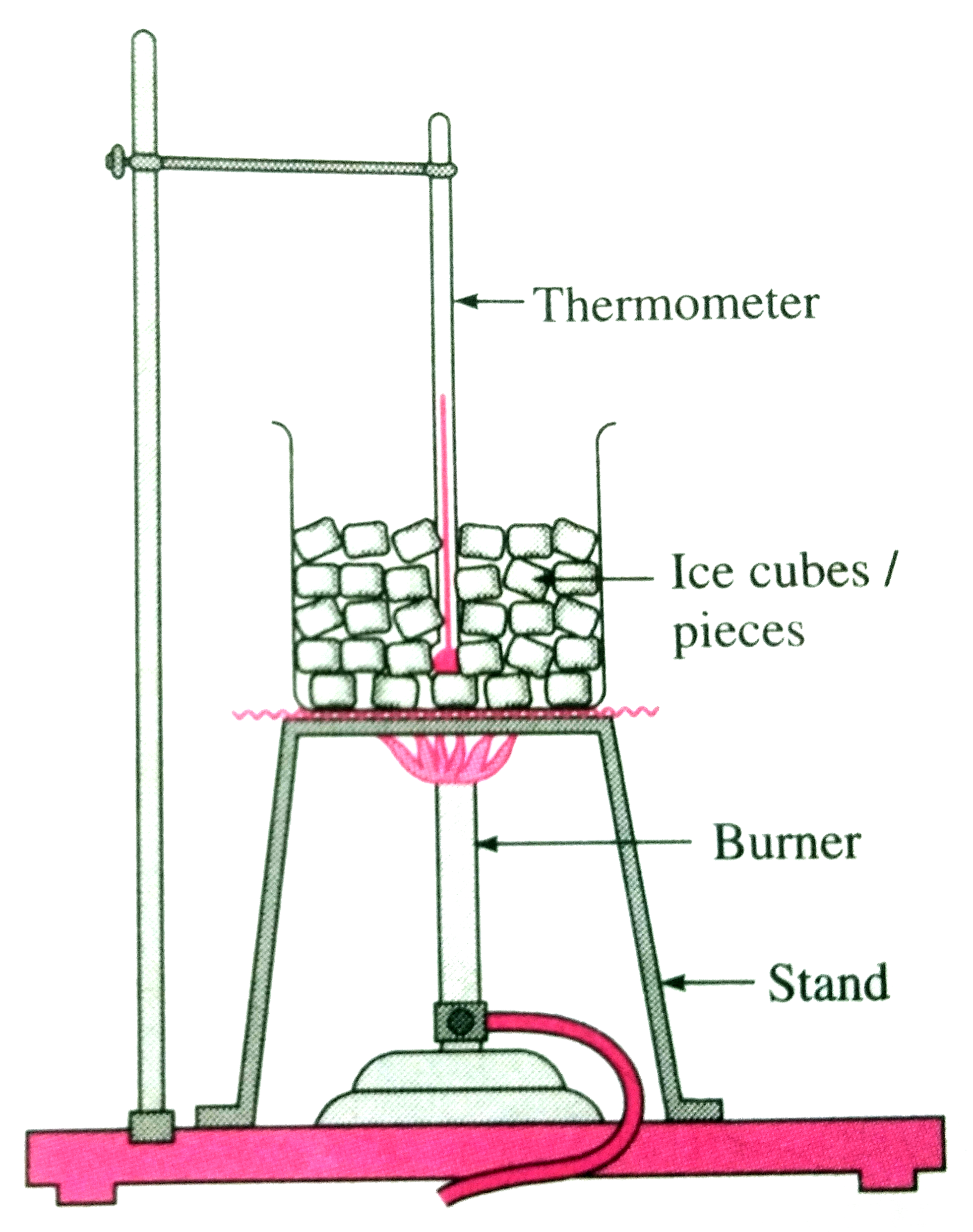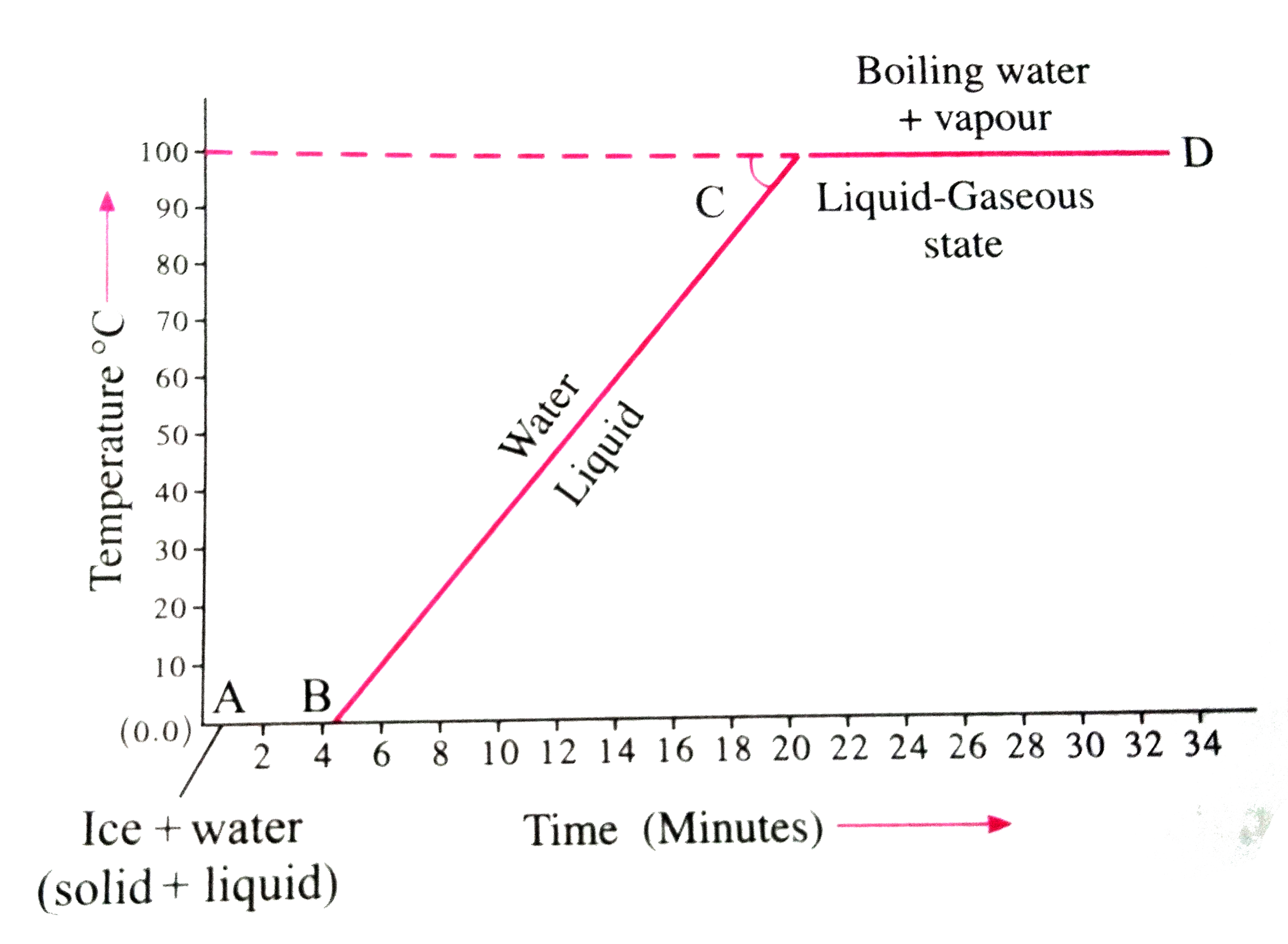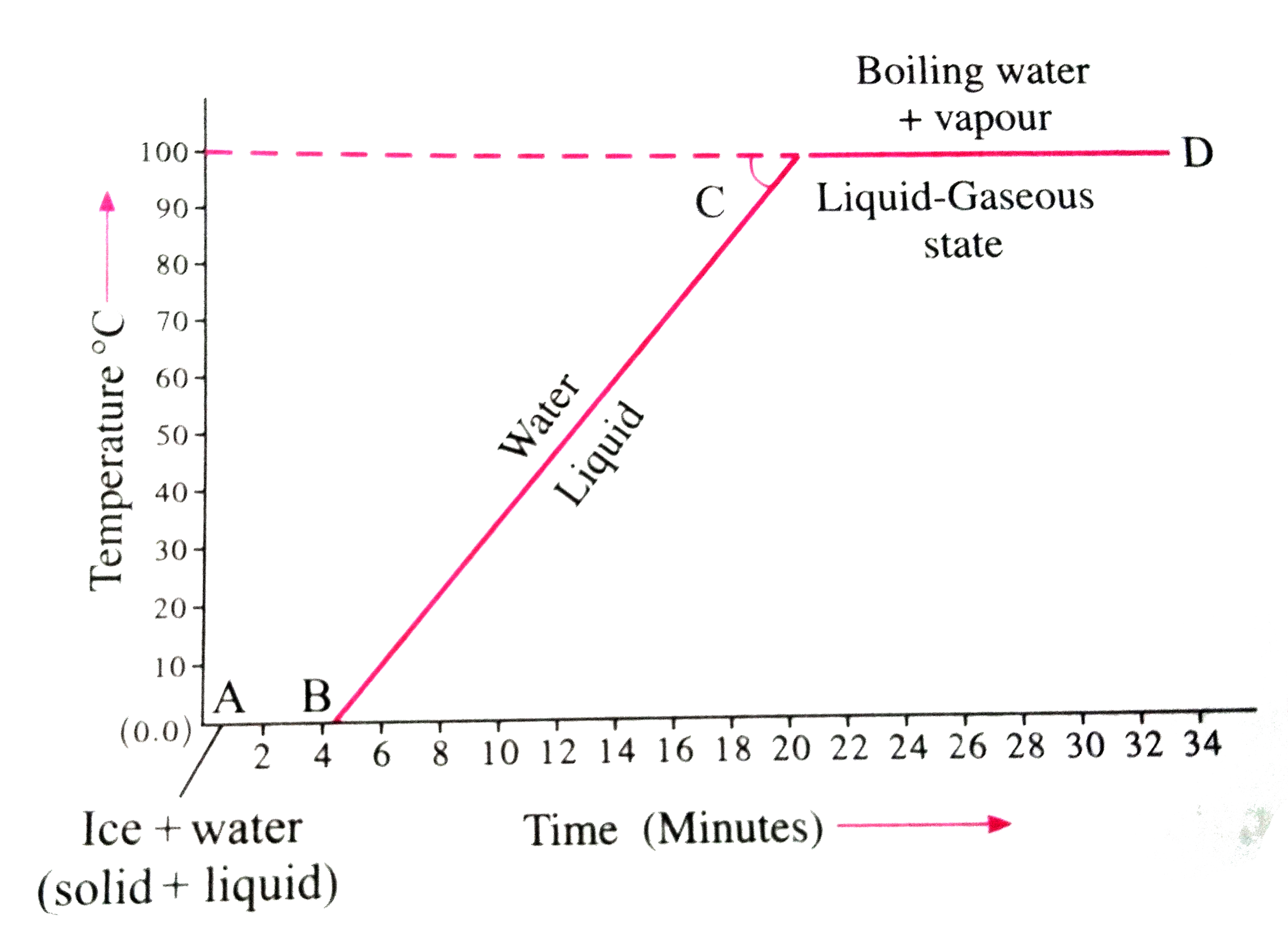(1) Take a few pieces of ice in a glass beaker as shown in figure.
(2) Insert the bulb of a thermometer in ice and measure its temperature.
(3) Put the beaker on a stand and heat the ice using a burner.
(4) Record the temperature using the thermometer after every minute.
(5) As the ice is heated,it starts melting. Stir the mixture of ice and water.
(6) Continue the heating even after ice starts melting.
(7) Draw a graph of temperature versus time.
Explain the role of latent heat in the change of state of a substance.


When a solid is heated, initially, its temperature increases.Here, the heat absorbed by the body ( substance ) is used in increasing the kinetic energy of the particle ( atomic, molecules, etc. ) of the body as well as for doing work against the forces of attraction between them . As the heating is continued,at a certain temperature ( melting point) , solide is converted into liquid.In this case, the temperature remains constant and the heat absorbed is used for weakening the bonds and conversion into liquid phase ( liquid state) .This heat is called the latent heat of fusion.
When a liquid is converted into the gaseous phase ( gaseous state), at the boiling point, the heat absorbed is used for breaking the bonds between the atoms or molecules.This heat is called the latent heat of vaporization.
Some solids,under certain conditions, are directly transformed into the gaseous phase. Here the heat is abosrbed but the temperature remains constant.The absorbed heat is used for breaking the bonds between atoms or molecules.This heat is called the latent of sublimation.
In general,latent heat is the heat absorbed or given out by a substance during a change of state at constant temperature.
In transformation from liquid to solid, gas to liquid and gas to solid, latent heat is given out by the body ( substance) .
Similar Questions
Insert the bulb of a thermometer in ice and measure its temperature.
View SolutionMercury thermometers can be used to measure temperatures upto
View Solution(1) Take a few pieces of ice in a glass beaker as shown in figure.

(2) Insert the bulb of a thermometer in ice and measure its temperature.
(3) Put the beaker on a stand and heat the ice using a burner.
(4) Record the temperature using the thermometer after every minute.
(5) As the ice is heated,it starts melting. Stir the mixture of ice and water.
(6) Continue the heating even after ice starts melting.
(7) Draw a graph of temperature versus time.

Explain the term latent heat of vaporization.
View Solution

(1) Take a few pieces of ice in a glass beaker as shown in figure.
(2) Insert the bulb of a thermometer in ice and measure its temperature.
(3) Put the beaker on a stand and heat the ice usinga burner.
(4) Record the temperature using the thermometer after every minute.
(5) As the ice is heated,it starts melting. Stir the mixture of ice and water.
(6) Continue the heating even after ice starts melting.
(7) Draw a graph of temperature versus time.

Explain the following temperature vs time graph.
View Solution(1) Take a few pieces of ice in a glass beaker as shown in figure.

(2) Insert the bulb of a thermometer in ice and measure its temperature.
(3) Put the beaker on a stand and heat the ice using a burner.
(4) Record the temperature using the thermometer after every minute.
(5) As the ice is heated,it starts melting. Stir the mixture of ice and water.
(6) Continue the heating even after ice starts melting.
(7) Draw a graph of temperature versus time.

Define latent heat of fusion
OR
What is latent heat of fusion ? State its units.
View Solution(1) Take a few pieces of ice in a glass beaker as shown in figure.

(2) Insert the bulb of a thermometer in ice and measure its temperature.
(3) Put the beaker on a stand and heat the ice using a burner.
(4) Record the temperature using the thermometer after every minute.
(5) As the ice is heated,it starts melting. Stir the mixture of ice and water.
(6) Continue the heating even after ice starts melting.
(7) Draw a graph of temperature versus time.

Define boiling point of a liquid. OR What is boiling point of a liquid ?
View Solution(1) Take a few pieces of ice in a glass beaker as shown in figure.

(2) Insert the bulb of a thermometer in ice and measure its temperature.
(3) Put the beaker on a stand and heat the ice using a burner.
(4) Record the temperature using the thermometer after every minute.
(5) As the ice is heated,it starts melting. Stir the mixture of ice and water.
(6) Continue the heating even after ice starts melting.
(7) Draw a graph of temperature versus time.

The specific latent heat of fusion of ice is 80cal/g .Explain this statement .
View Solution
(1) Take a few pieces of ice in a glass beaker as shown in figure.
(2) Insert the bulb of a thermometer in ice and measure its temperature.
(3) Put the beaker on a stand and heat the ice using a burner.
(4) Record the temperature using the thermometer after every minute.
(5) As the ice is heated,it starts melting. Stir the mixture of ice and water.
(6) Continue the heating even after ice starts melting.
(7) Draw a graph of temperature versus time.

Define specific latent heat of fursion. OR
What is specific latent heat of fusion? State its units.
View Solution(1) Take a few pieces of ice in a glass beaker as shown in figure.

(2) Insert the bulb of a thermometer in ice and measure its temperature.
(3) Put the beaker on a stand and heat the ice using a burner.
(4) Record the temperature using the thermometer after every minute.
(5) As the ice is heated,it starts melting. Stir the mixture of ice and water.
(6) Continue the heating even after ice starts melting.
(7) Draw a graph of temperature versus time.

What is meant by latent heat ?How will the state of matter transform if latent heat is given off ?
View Solution(1) Take a few pieces of ice in a glass beaker as shown in figure.

(2) Insert the bulb of a thermometer in ice and measure its temperature.
(3) Put the beaker on a stand and heat the ice using a burner.
(4) Record the temperature using the thermometer after every minute.
(5) As the ice is heated,it starts melting. Stir the mixture of ice and water.
(6) Continue the heating even after ice starts melting.
(7) Draw a graph of temperature versus time.

The specific latent heat of fusion of silver is 88.2kJ/kg. Explain this statement.
View Solution
